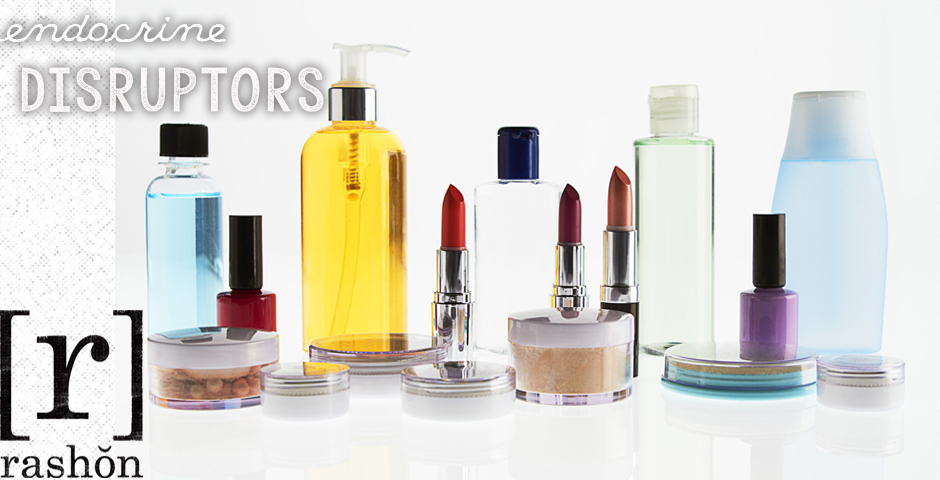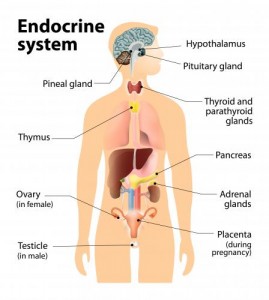Maybe you’ve heard the term “endocrine disruptors” being thrown around (or maybe you haven’t, and that’s okay!), but do you know what that means and the implications it has on your health? This is an important topic, and can be pretty complex, but I’m going to break it down so it’s a bit easier to understand.
What is the Endocrine System?
The endocrine system is comprised of the Hypothalamus, the Pituitary Gland, the Pineal Gland, the Thyroid, the Parathyroid, the Adrenal Glands, the Pancreas, the Ovaries or Testes and the Kidneys. The Endocrine System is responsible for secreting hormones into our bloodstream and regulating those hormones. Proper hormone balance is vital for metabolism, stress response, reproduction, blood sugar control, and bone building and resorption.
Having a healthy endocrine system and balanced hormones is important for our health overall. When our hormones (such as stress, thyroid, pituitary, and sex hormones) get out of whack, we start to see some health issues including adrenal fatigue, hypothyroidism (along with Hashimoto’s), hyperthyroidism (including Grave’s Disease), pituitary malfunction, sexual dysfunction, diabetes, weight gain and more. Our endocrine system is a workhorse, and taking care of it is important. This means managing stress, eating right (e.g., lots of clean protein, healthy fats and loads of non-starchy veggies), exercising regularly and limiting the toxins we put in, and on, our bodies!
What are Endocrine Disruptors?
Endocrine disruptors are chemicals that may interfere with the body’s endocrine system and produce adverse developmental, reproductive, neurological, and immune effects in humans. Many substances, both natural and man-made, are thought to cause endocrine disruption. These are chemicals and toxins and that we come in contact with Every. Single. Day. Pharmaceuticals, dioxin and dioxin-like compounds (environmental toxins), polychlorinated biphenyls, DDT and other pesticides, and components of plastic such as bisphenol A are all examples of endocrine disruptors. These may be found in many everyday products– including plastic bottles, metal food cans, detergents, flame retardants, food, toys, cosmetics, and pesticides.
Endocrine disruptors can:
- Mimic naturally occurring hormones in the body like estrogens (the female sex hormone), androgens (the male sex hormone), and thyroid hormones, potentially producing overstimulation.
- Bind to a receptor within a cell and block the endogenous (made in our bodies) hormone from binding. The normal signal then fails to occur and the body fails to respond properly.
- Interfere or block the way natural hormones or their receptors are made or controlled.
So, in simple terms: these substances can act like hormones in our body (but they aren’t our natural hormones!) or bind to cells like our hormones would. As a result, our body believes there are higher levels of hormones than necessary which can cause us to stop producing hormones, or make our organs and glands work overtime to correct the issue; it can block normal hormone signals so that we don’t produce enough of the proper hormones, so our body doesn’t respond the way it needs to; or it can completely block the way our natural hormones are made. All of these things start to cause imbalances leading to some of the health issues listed above.
As a side note, many endocrine disruptors are toxic chemicals and can cause all sorts of health issues – not just hormone-related issues. Finding ways to avoid these disruptors is critical to better health and just safer living overall. Don’t forget that it’s not just what we eat or consume, but what we put on our bodies as well. Our skin is our largest organ, and it absorbs 60+% of whatever we put on it. That means that what we’re putting on bodies goes straight into our bloodstream.
Don’t let this stress you out, though. In Part 2, I will tell you where endocrine disruptors can be found, and how to avoid them. It’s not about making huge sweeping changes to your lifestyle, diet and the products you use, it’s about knowing the facts and making safer choices, and replacing items when you can. Every small change helps.





0 Comment